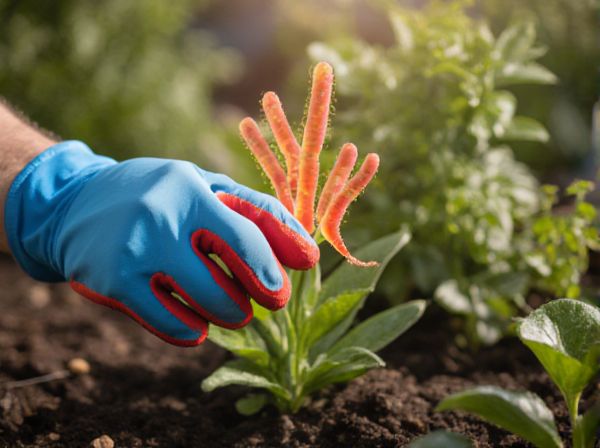
Thermophilic Bacteria vs Mesophilic Bacteria Illustration
Thermophilic bacteria thrive in high temperatures between 45degC and 70degC, accelerating the decomposition of organic matter during the initial hot phase of composting. Mesophilic bacteria operate at moderate temperatures ranging from 20degC to 45degC, breaking down materials in the early and final stages of composting, ensuring the stabilization of the compost. Both types of bacteria are essential for an efficient composting process, as thermophilic bacteria rapidly reduce pathogens and mesophilic bacteria complete the breakdown for nutrient-rich soil amendment.
Table of Comparison
| Feature | Thermophilic Bacteria | Mesophilic Bacteria |
|---|---|---|
| Optimal Temperature | 45degC - 70degC | 20degC - 45degC |
| Decomposition Speed | Fast | Moderate |
| Heat Tolerance | High | Low to Moderate |
| Compost Maturity Time | 2 to 4 weeks | 4 to 8 weeks |
| Common Usage | Hot composting | Cold/warm composting |
| Pathogen Reduction | Effective | Less effective |
| Key Role | Rapid organic matter breakdown | Initial decomposition phase |
Introduction to Thermophilic and Mesophilic Bacteria in Composting
Thermophilic bacteria thrive at high temperatures between 104degF and 160degF, playing a crucial role in breaking down organic matter rapidly during the active composting phase. Mesophilic bacteria operate optimally at moderate temperatures ranging from 68degF to 113degF, initiating the decomposition process and stabilizing compost during the cooling phase. Understanding the distinct temperature preferences and metabolic activities of these bacteria enhances efficient compost management and nutrient recycling.
Defining Thermophilic Bacteria: Characteristics and Role
Thermophilic bacteria thrive at temperatures between 45degC and 80degC, playing a crucial role in the high-temperature phase of composting by rapidly breaking down complex organic materials such as cellulose and lignin. These bacteria produce heat-resistant enzymes that accelerate the decomposition process, ensuring pathogen destruction and nutrient stabilization. Their activity enhances compost quality by eliminating harmful microorganisms and promoting the formation of nutrient-rich humus.
Mesophilic Bacteria: Functions in the Composting Process
Mesophilic bacteria thrive at moderate temperatures between 20degC and 45degC, initiating the early stages of the composting process by breaking down organic matter such as sugars and proteins. These bacteria facilitate the rapid decomposition of easily degradable materials, creating conditions that promote the growth of thermophilic bacteria in the subsequent hot phase. Their metabolic activities generate heat and organic acids, which help stabilize the compost and prepare it for further microbial activity during thermophilic stages.
Temperature Ranges: Thermophilic vs Mesophilic Bacteria
Thermophilic bacteria thrive in high-temperature ranges between 45degC and 70degC, accelerating the decomposition process during the active composting phase. Mesophilic bacteria operate optimally at moderate temperatures, typically between 20degC and 45degC, initiating decomposition in the early stages of composting. Understanding these temperature ranges is crucial for managing compost piles to ensure efficient microbial activity and organic matter breakdown.
Stages of Composting: Bacterial Succession Explained
Thermophilic bacteria dominate the high-temperature phase of composting, rapidly breaking down complex organic materials at temperatures between 45degC and 70degC, accelerating pathogen destruction and organic matter stabilization. Mesophilic bacteria thrive during the initial and cooling stages, operating optimally between 20degC and 40degC to decompose simple sugars and proteins, preparing substrates for thermophilic activity and final maturation. Understanding the bacterial succession from mesophilic to thermophilic phases is crucial for optimizing composting efficiency and ensuring effective organic waste transformation.
Benefits of Thermophilic Bacteria in Accelerating Compost Breakdown
Thermophilic bacteria thrive at high temperatures between 45degC and 70degC, accelerating the compost breakdown process by quickly decomposing complex organic materials such as cellulose and lignin. These heat-loving microbes enhance pathogen elimination and reduce composting time compared to mesophilic bacteria, which operate optimally at moderate temperatures of 20degC to 45degC. The intense activity of thermophilic bacteria not only speeds up nutrient recycling but also produces stabilized compost with higher microbial diversity, improving soil fertility and plant growth.
Mesophilic Bacteria and the Initial Decomposition Phase
Mesophilic bacteria dominate the initial decomposition phase of composting, thriving at moderate temperatures between 20degC and 45degC. These bacteria efficiently break down readily degradable organic materials such as sugars, proteins, and starches, producing heat that subsequently raises the pile's temperature. Their activity sets the stage for thermophilic bacteria, which take over as temperatures exceed 45degC, driving the composting process toward pathogen reduction and further organic matter stabilization.
Impact on Pathogen Reduction: Thermophilic vs Mesophilic Action
Thermophilic bacteria operate at higher temperatures (45-70degC), rapidly breaking down organic matter and effectively reducing pathogens through sustained heat generation during composting. Mesophilic bacteria function best at moderate temperatures (20-45degC), contributing to initial decomposition but achieving lower pathogen kill rates compared to thermophilic phases. The transition from mesophilic to thermophilic stages is critical for maximizing pathogen reduction, ensuring safer, sanitized compost output.
Optimizing Compost for Balanced Bacterial Activity
Thermophilic bacteria thrive at temperatures between 104degF and 160degF, accelerating the breakdown of organic matter during the initial composting phase. Mesophilic bacteria function optimally at moderate temperatures, around 70degF to 104degF, sustaining decomposition during the cooling and curing stages. Balancing thermophilic and mesophilic bacterial activity by managing moisture, aeration, and temperature enhances compost quality and accelerates nutrient-rich humus formation.
Practical Tips for Managing Thermophilic and Mesophilic Bacteria in Compost
Maintaining optimal temperature ranges is crucial for managing thermophilic and mesophilic bacteria in compost, with thermophilic bacteria thriving between 113degF and 160degF, accelerating the breakdown of tough organic materials, while mesophilic bacteria dominate at 68degF to 113degF, decomposing softer waste during initial and final stages. Turning the compost regularly ensures even heat distribution and oxygen flow, promoting thermophilic activity and preventing anaerobic zones that mesophilic bacteria prefer. Balancing moisture levels around 40-60% supports bacterial activity, with thermophilic bacteria requiring slightly higher moisture for efficient decomposition compared to mesophilic bacteria.
Thermophilic Bacteria vs Mesophilic Bacteria Infographic

 gardendif.com
gardendif.com